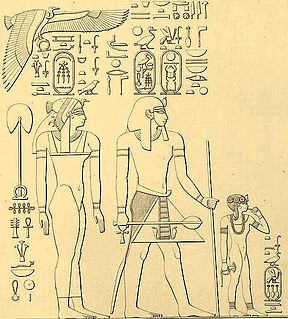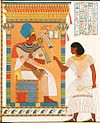God's Wife (Egyptian ḥmt nṯr) is a title which was often allocated to royal women during the Eighteenth Dynasty of Egypt. The term indicates an inherited sacral duty, in which the role of "God's Wife" passed from mother to daughter. The role could also exist among siblings, as in the case of the role of "God's Wife" being shared or passed by daughters of Ahmose-Nefertari, Satamun (I) and her sister, Ahmose-Merytamun. [1]

The Egyptian language was spoken in ancient Egypt and was a branch of the Afro-Asiatic languages. Its attestation stretches over an extraordinarily long time, from the Old Egyptian stage. Its earliest known complete written sentence has been dated to about 2690 BC, which makes it one of the oldest recorded languages known, along with Sumerian.
The Eighteenth Dynasty of Egypt is classified as the first dynasty of the New Kingdom of Egypt, the era in which ancient Egypt achieved the peak of its power. The Eighteenth Dynasty spanned the period from 1549/1550 to 1292 BC. This dynasty is also known as the Thutmosid Dynasty for the four pharaohs named Thutmose.

Ahmose-Nefertari of Ancient Egypt was the first Queen of the 18th Dynasty. She was a daughter of Seqenenre Tao and Ahhotep I, and royal sister and the great royal wife of pharaoh, Ahmose I. She was the mother of king Amenhotep I and may have served as his regent when he was young. Ahmose-Nefertari was deified after her death.
Despite certain allegations found online, the role of "God's Wife" is not the same as the title "God's Wife of Amun", which is a separate sacral title, involved in the "Divine Cycle" myth of the deity Amun. [2] [3] Only two Eighteenth Dynasty queens held this title, Ahhotep I and Ahmose-Nefertari. [4]

God's Wife of Amun was the highest-ranking priestess of the Amun cult, an important religious institution in ancient Egypt. The cult was centered in Thebes in Upper Egypt during the Twenty-fifth and Twenty-sixth dynasties. The office had political importance as well as religious, since the two were closely related in ancient Egypt.

Ancient Egyptian deities are the gods and goddesses worshipped in ancient Egypt. The beliefs and rituals surrounding these gods formed the core of ancient Egyptian religion, which emerged sometime in prehistory. Deities represented natural forces and phenomena, and the Egyptians supported and appeased them through offerings and rituals so that these forces would continue to function according to maat, or divine order. After the founding of the Egyptian state around 3100 BC, the authority to perform these tasks was controlled by the pharaoh, who claimed to be the gods' representative and managed the temples where the rituals were carried out.
Amun is a major ancient Egyptian deity who appears as a member of the Hermopolitan Ogdoad. Amun was attested from the Old Kingdom together with his wife Amaunet. With the 11th dynasty, Amun rose to the position of patron deity of Thebes by replacing Montu.











